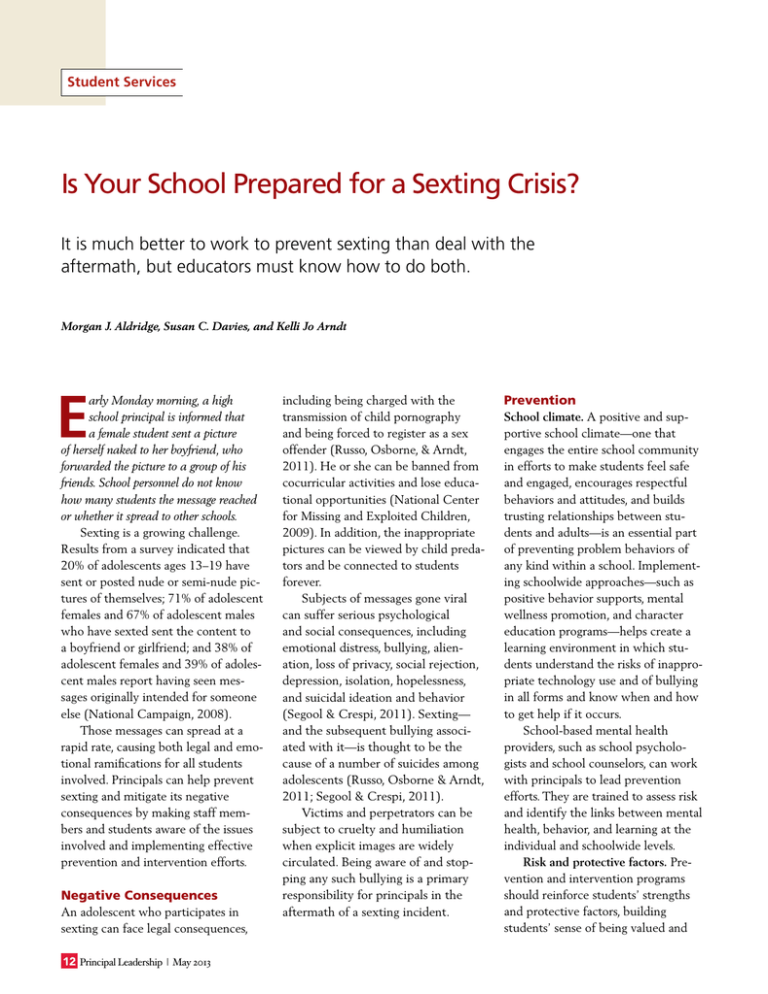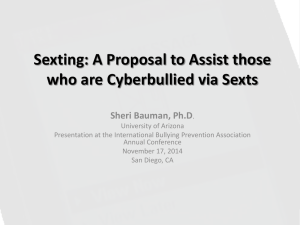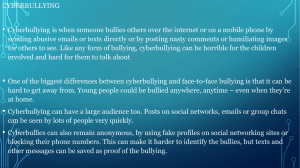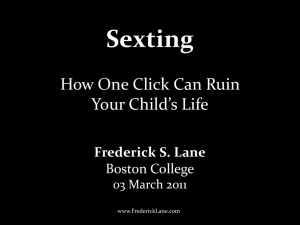Is Your School Prepared for a Sexting Crisis?
advertisement

Student Services Is Your School Prepared for a Sexting Crisis? It is much better to work to prevent sexting than deal with the aftermath, but educators must know how to do both. Morgan J. Aldridge, Susan C. Davies, and Kelli Jo Arndt E arly Monday morning, a high school principal is informed that a female student sent a picture of herself naked to her boyfriend, who forwarded the picture to a group of his friends. School personnel do not know how many students the message reached or whether it spread to other schools. Sexting is a growing challenge. Results from a survey indicated that 20% of adolescents ages 13–19 have sent or posted nude or semi-nude pictures of themselves; 71% of adolescent females and 67% of adolescent males who have sexted sent the content to a boyfriend or girlfriend; and 38% of adolescent females and 39% of adolescent males report having seen messages originally intended for someone else (National Campaign, 2008). Those messages can spread at a rapid rate, causing both legal and emotional ramifications for all students involved. Principals can help prevent sexting and mitigate its negative consequences by making staff members and students aware of the issues involved and implementing effective prevention and intervention efforts. Negative Consequences An adolescent who participates in sexting can face legal consequences, 12 Principal Leadership | May 2013 including being charged with the transmission of child pornography and being forced to register as a sex offender (Russo, Osborne, & Arndt, 2011). He or she can be banned from cocurricular activities and lose educational opportunities (National Center for Missing and Exploited Children, 2009). In addition, the inappropriate pictures can be viewed by child predators and be connected to students forever. Subjects of messages gone v ­ iral can suffer serious psychological and social consequences, including ­emotional distress, bullying, alienation, loss of privacy, social rejection, depression, isolation, hopelessness, and suicidal ideation and behavior (Segool & Crespi, 2011). Sexting— and the subsequent bullying associated with it—is thought to be the cause of a number of suicides among adolescents (Russo, Osborne & Arndt, 2011; Segool & Crespi, 2011). Victims and perpetrators can be subject to cruelty and humiliation when explicit images are widely circulated. Being aware of and stopping any such bullying is a primary responsibility for principals in the aftermath of a sexting incident. Prevention School climate. A positive and supportive school climate—one that engages the entire school community in efforts to make students feel safe and engaged, encourages respectful ­behaviors and attitudes, and builds trusting relationships between students and adults—is an essential part of preventing problem behaviors of any kind within a school. Implementing schoolwide approaches—such as positive behavior supports, mental wellness promotion, and character education programs—helps create a learning environment in which students understand the risks of inappropriate technology use and of bullying in all forms and know when and how to get help if it occurs. School-based mental health providers, such as school psychologists and school counselors, can work with principals to lead prevention efforts. They are trained to assess risk and identify the links between mental health, behavior, and learning at the individual and schoolwide levels. Risk and protective factors. Prevention and intervention programs should reinforce students’ strengths and protective factors, building students’ sense of being valued and ability to resist risky behavior. Schools are well-suited to address many of the factors that can lead to sexting behavior. Research indicates that 51% of adolescent girls and 18% of adolescent males admitted to sexting because of pressure from someone of the opposite sex (National Campaign, 2008). Students, particularly girls, who are at risk for giving into other types of peer pressure may also be at risk for sexting. Conversely, a high level of self-esteem is a powerful counter to peer pressure (Zimmerman, Copeland, Shope, & Dielman, 1997) and may serve as a protective factor to sexting. Students who have supportive families and friends also may be less prone to peer pressure and participating in sexting because they receive validation from others. Preventive education. Educating students and staff members about the risks of sexting is one of the most important factors in preventing and changing the behavior (National Center for Missing and Exploited Children, 2009; Segool & Crespi, 2011; Siegle, 2010; Russo, Osborne & Arndt, 2011). For instance, 66% of adolescent girls and 60% of adolescent boys report participating in sexting because they think it is “fun or flirtatious” (National Campaign, 2008). Being accustomed to forwarding anything interesting, students may not think before sending an inappropriate picture to dozens of friends and acquaintances. Helping students understand the social, emotional, and psychological harm sexting can cause, as well as its legal risks, can deter students. An education-based sexting prevention program in Texas (Before You Text, http://beforeyoutext.com), offers students the opportunity to learn about the consequences of ­sexting through a series of modules and quizzes. Another interactive resource, Project PRO (Privacy and Reputation Online) educates teens and parents about the potential ­consequences of online behavior. (www.ikeepsafe.org/educators/more/ project-pro/3.) Sexting also can be incorporated into existing curricula that includes information about appropriate online behavior, bullying, and peer pressure. Parents and staff members are important to prevention and intervention efforts. School-based mental health professionals can help develop appropriate training for and communications to parents to encourage them to talk to their children and monitor their activities closely. Policy and Planning Sexting incidents often require a crisis intervention, so having policies and a plan in place is essential. All elements of the plan should be clearly stated and defined in the school’s code of conduct and the crisis team should be prepared to respond to the specific issues involved in sexting. The school crisis team should implement a needs assessment to determine the resources needed to combat sexting, such as curricular materials, training programs, personnel, and school-community partnerships. The needs assessment should also include a survey of Parents and staff members are important to prevention and intervention efforts. School-based mental health professionals can help develop appropriate training for and communications to parents to encourage them to talk to their children and monitor their activities closely. Created in collaboration with the National Association of School Psychologists (NASP) and the School Social Work Association of America (SSWAA) to facilitate partnerships between principals and school psychologists and to remove barriers to learning. Additional resources are available at www.nasponline.org /resources/principals. May 2013 | Principal Leadership 13 Student Services s­ tudents, parents, and staff members to establish the prevalence of sexting in the school district (Russo, Osborne, & Arndt, 2011). Policies should be disseminated to students, parents, and staff members so that everyone is aware of the consequences. Current laws. The laws applied in sexting cases are evolving, but currently most are related to child pornography and were not written for sexting situations. Laws differ from state to state, but in many states, students involved in sexting can be charged with felonies, including the production and distribution of child pornography. This charge can lead to mandatory registration as a sex offender. A typical sexting scenario involves a girl taking illicit pictures of herself and sending them to her boyfriend, who sends the pictures to his friends. Under current laws in some states, the girl could be charged with a more serious crime (production of child pornography) than the boyfriend (distribution of child pornography). In some states, if one changes the media in which the pornography was taken (e.g., transfer from phone to computer), he or she can also be charged with child pornography. Because sexting is a crime in most states, school officials are typically required to report sexting incidents to the police. A school resource officer can investigate if a sexting situation is suspected. Police can then obtain search warrants and confiscate phones and computers. Current school practices. Sexting is considered a form of bullying in many districts and is often governed by general bullying policies. Because sexting can be misconstrued by adolescents as consensual by the original sender of the text or image, however, 14 Principal Leadership | May 2013 it is important that administrators develop sexting-specific policies and ensure that students, parents, and staff members are aware of them. As with all behavior policies, simply sending copies of the student handbook home or making the student code of conduct available on the school’s website is not enough. Best practice involves verbally communicating sexting policies to all parties, including students, parents, and staff members. Ideally, this verbal communication takes place during orientation, backto-school activities, and teacher-parent ­conferences. Districts have reported using suspension and expulsion as consequences to sexting, but research suggests that disciplinary removal is an ineffective consequence that is associated with several unintended consequences (Christle, Nelson, & Jolivette, 2004). A more effective remedial consequence might be for all the students involved to receive an in-school suspension during which they learn about the long-term consequences of sexting and receive psychological interventions to help them cope with their actions and prevent similar behaviors from occurring in the future. Districts should share their sexting policies with local law enforcement agencies so that they understand what kind of role they will be expected to play when sexting incidents occur. In addition, like the underreporting of bullying incidents (Diamanderos, Downs, & Jenkins, 2008), principals have indicated that the biggest challenge they encounter is that many incidents go unreported (personal communications). Therefore, school policies should encourage students to come forward while ensuring them that their anonymity will be p ­ rotected. Intervention When a staff member learns about a sexting incident, he or she should report it to an administrator, who will alert the sexting crisis intervention team. If any member of the team (or another staff member) is shown the suspected picture, the phone should be confiscated and law enforcement should be notified. The principal can delegate the following tasks in the crisis plan to crisis team members according to their professional roles. School administrators. The school administrator determines when it is appropriate to contact law enforcement agencies and the parents of the students who were involved. The administrator is responsible for implementing school-based consequences for both sexting and any subsequent bullying, keeping in mind the emotional effects for both the victim and perpetrators. Suspensions and expulsions may not be in the best interest of the students, especially if they are going to be unsupervised at home, but administrators should also consider that students may face bullying if they remain in school. An alternative is for students to come to school and continue to receive academic instruction and other needed interventions until a decision is made regarding the legality of their actions. School-based mental health professionals. In addition to their role in prevention and policy development, school psychologists, counselors, and social workers are trained in crisis prevention and intervention, problem solving, and positive behavior supports and interventions. They can counsel students who are at risk for or who have already been affected by sexting and work with families to help minimize the emotional consequences of Principals, Have You… n Assessed the extent of sexting problems in your building? n Developed a sexting crisis team consisting of administrators, school psychologists, school counselors, members of local law enforcement agencies, teachers, parents, social workers, and mental health professionals? n Ensured that all members of the sexting crisis team understand their roles in both the prevention of and the response to sexting incidents? n Worked collaboratively with school-based mental health professionals to review crisis prevention and intervention strategies? n Ensured that the students in your school have been taught the long-term consequences of sexting? n Cultivated a positive school climate using character education programs or positive behavior supports? n Contacted your local law enforcement agency and determined its role in your sexting policy and response plan? n Determined what your state laws say about sexting? n Established a policy for bullying, which includes language related to cyberbullying and sexting? n Verbally shared your sexting policy and sexting crisis response plan with students, staff members, and parents?, not merely included the policy in the school handbook and on the school website? the incident and prevent the behavior in the future. They also can make appropriate referrals to communitybased providers and help coordinate recommended supports provided in school. Teachers. All teachers should understand the signs of students who may be in distress because of sexting (or bullying), be available to reach out and listen if the student will talk to them, and know the proper referral process. In addition, teachers should be on the lookout for discussions about sexting because an incident will often create a buzz among students. Members of the crisis team or teachers with strong relationships with students can be assigned to spend time in common areas to learn what students are doing and saying. If teachers suspect a sexting incident, they should report what was said and the names of students who were discussing the incident to the appropriate administrator. Law enforcement agencies. Once administrators have notified law enforcement agencies, as required by law, police officers will conduct a thorough investigation. They may take phones that have been confiscated by school staff members containing the sexting pictures or computers that have been involved in the incident. Law enforcement agencies play a vital role in planning for and responding to sexting crises, and principals should ensure that they are involved in both the prevention of and response to sexting crises. Conclusion Law enforcement agencies play a vital role in planning for and responding to sexting crises, and principals should ensure that they are involved in both the prevention of and response to sexting crises. After a sexting crisis, the team can examine the policy and plan that were executed to determine what was done well, what could be improved, and what was unforeseen. Appropriate adjustments can be made accordingly. Sexting is likely occurring in every school district, whether reported or May 2013 | Principal Leadership 15 Student Services not. Because of the psychologically destructive nature of this new form of bullying, all school personnel must work together on prevention, policies, and intervention. Principals are integral in such strategy development. PL References n Christle, C., Nelson, M. C., & Jolivette, K. (2004). School characteristics related to the use of suspension. Education & Treatment of Children, 27(4), 509–526. n Diamanduros, T., Downs, E., & Jenkins, S. J. (2008). The role of the school psychologist in assessment, prevention, and intervention of cyberbullying. Psychology in the Schools, 45(8), 693–704. n National Campaign to Prevent Teen and Unplanned Pregnancy. (2008). Sex and tech: Results from a survey of teens and young adults. Retrieved from www 16 Principal Leadership | May 2013 .thenationalcampaign.org/sextech/pdf /sextech_summary.pdf n National Center for Missing and Exploited Children. (2009). Tips to prevent sexting. Retrieved from www.doj.state .wi.us/news/files/SextingPrevention.pdf n Russo, C. J., Osborne, A. G., & Arndt, K. J. (2011). Cyberbullying and sexting: Recommendations for school policy. West’s Education Law Reporter, 269(2), 427–434. n Siegle, D. (2010). Cyberbullying and sexting: Technology abuses of the 21st century. Gifted Child Today, 32(2), 14–15, 65. n Segool, N. K., & Crespi, T. D. (2011). Sexting in the schoolyard. Communiqué, 39(8). Retrieved from National Association of School Psychologists website: www.nasp online.org/publications/cq/39/8/sexting-in -the-schoolyard.aspx n Zimmerman, M. A., Copeland, L. A., Shope, J. T., & Dielman, T. E. (1997). A longitudinal study of self-esteem: Implications for adolescent development. Journal of Youth and Adolescence, 26(2), 117–141. Morgan J. Aldridge is a psychology graduate student at the University of Dayton. She is currently completing her internship in Madeira City Schools. Susan C. Davies is an assistant professor and a coordinator of the school psychology program at the University of Dayton. Kelli Jo Arndt is an assistant professor and a school counseling clinical coordinator at the University of Dayton. Authors’ note: Portions of this article are reprinted with permission from “You Found the Sext, What to Do Next? How School Psychologists Can Assist with Prevention, Policy, and Intervention,” from The Ohio School Psychologist, 58(2).







